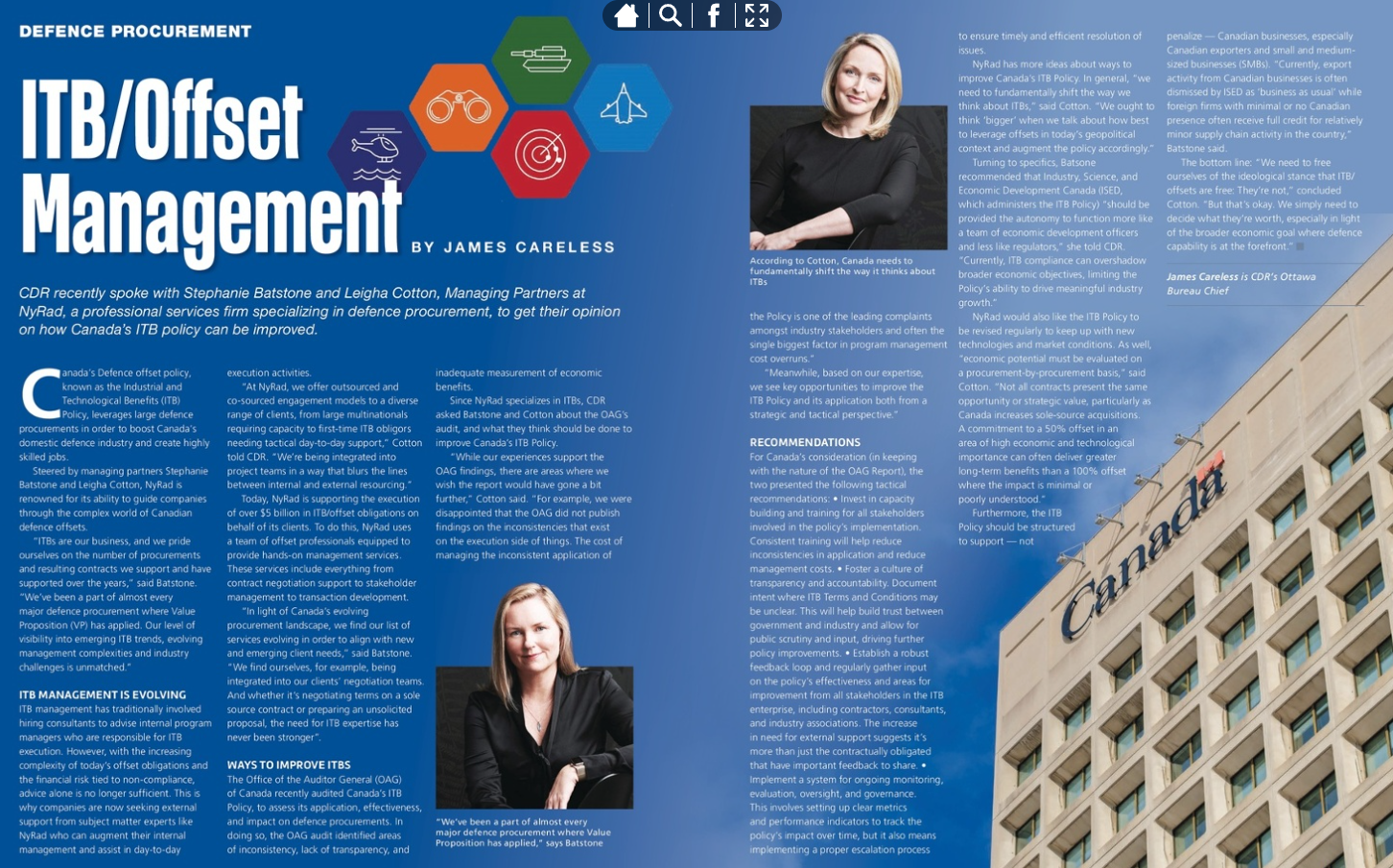Streamlining ITB/VP Bidding Documents: NyRad Recommendations
As specialists in ITB/VP and Canadian defence procurement, NyRad is aware of ISED’s ongoing review and consultation process of ITB/VP bidders’ documents. Despite not being consulted, we believe we have valuable insights to share, given that we’ve supported capture efforts on almost every crown procurement since Value Proposition was introduced. Based on our experience and the shared goals of increased efficiency and enhanced clarity, we offer the following recommendations for Canada’s consideration:
- Simplify Company Business Plan Requirements
The current requirement for information in the ITB Company Business Plan is extensive and can be overwhelming for bidders. Given that the information is unnecessary for evaluating a company’s ITB/VP offer, we suggest streamlining the requirement to essential information only – requiring bidders to provide a clear picture of its business and that of its eligible donors. The information required, for instance, could be reduced to the following:
- Describe the company’s core business activities and capabilities.
- Outline the company’s structure, including an organizational chart visually representing the interrelationships between business entities.
- Include the location of relevant business entities.
- Describe the company’s strategic business objectives related to the procurement.
- Identify key personnel (relevant to the procurement opportunity) and their relevant experience.
- Replace SMB and Regional Plans with a Value Proposition Plan
The SMB Plan and Regional Plan could be consolidated into a single Value Proposition Plan. The VP plan would require bidders to detail how they intend to fulfill their ITB/VP commitments and include meaningful, procurement-specific information, including:
- Provide the company’s strategy for meeting each of the ITB/VP commitments made in the offer (ex: R&D, Direct Work, Skills Development & Training, SMB, regional commitments, etc.).
- Provide projected outcomes and their impact on Canadian industry.
- Outline risk mitigation strategies that are in place to ensure the company can meet its commitments. Identify previous experience that will support the company’s ability to deliver.
- Clarify the Process for using Banked Transactions
Banked Transactions can be a critical factor in a bidder’s ITB/VP fulfillment strategy, yet Canada’s expectations when it comes to using them at bid time are confusing. Clear guidance is needed on:
- The documentation required at bid time (original vs. procurement-specific transaction templates).
- The value of the transaction being considered at bid time (total value vs. credited to date).
- The requirements for breaking pooled transactions into parts and leveraging these parts for identification purposes in a bid. Specifically:
- Documentation Required (annual bank statement for entire transaction vs. portion being applied)
- Timing requirements for securing portioned bank statements (e.g., must they be issued before the RFP release?)
- Process/considerations when dividing a pooled transaction. Verification and Crediting process related to pooled transactions that have been portioned.
- Organize ITB/VP Volume by Section
Providing a standardized organization for the ITB/VP Volume would greatly assist bidders in preparing their documentation. A clear structure with defined sections for the different deliverables described in the RFP would streamline preparation and evaluation.
- Detail Terms and Conditions in Bidders Instructions and Evaluation Plan
The Bidders Instructions and Evaluation Plan should explicitly reference the Terms and Conditions necessary to fully understand the instructions. This would ensure that bidders are aware of all requirements and can adequately address them in their proposals.
- Streamline Export Plan Requirements
When the Export Pillar is leveraged, bidders are asked to submit two separate export plans – regardless of whether they have committed to exporting from Canada or not. Responding to the information requested in these documents is time-consuming and often redundant. We recommend consolidating the Export ask into a single Export plan. We also suggest that the export plan only be required if the bidder has made value proposition commitments to export.
Key requirements in a single Export plan might be:
- Export Strategy: An outline of the intended export activities, target markets, and timelines.
- Long-term Economic Impact: An analysis of the expected economic benefits to Canada from the proposed exports.
- Risk Management: A plan for managing potential risks associated with export activities.
In conclusion, our recommendations aim to refine the ITB/VP bidders’ documents to ensure a more streamlined, efficient, and focused bidding process. By reducing unnecessary complexity and focusing on pertinent information, we move towards a more transparent and bidder-friendly process. We encourage ISED to consider these recommendations and welcome further dialogue to enhance the ITB/VP framework for the future.
You May Also Be Interested In...

Editorial: ITB/Offset Management -How Canada’s ITB Policy Can Be Improved
Excited to share that NyRad is featured in the latest edition of the Canadian Defence Review.


